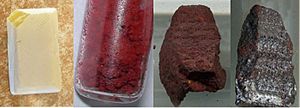Phosphorus facts for kids
Phosphorus is a chemical element with the symbol P. Its atomic number is 15, which means it has 15 protons. You won't find phosphorus as a pure element in nature. Instead, it's usually part of compounds called phosphates. Phosphorus can look like a red powder or a white, waxy solid.
Contents
What it's Like (Properties)
Physical Properties
Phosphorus comes in different forms, like different versions of the same thing. The most common forms are white phosphorus and red phosphorus.
- White phosphorus is a waxy, white solid. When it's super pure, it has no color at all. It doesn't dissolve in water, but it can dissolve in a liquid called carbon disulfide. When white phosphorus is in the air, it slowly turns light yellow. It also glows in the dark because it reacts very slowly with the air.
- If you expose white phosphorus to sunlight or heat it up, it changes into the red form. Red phosphorus is much safer. It doesn't catch fire on its own, and it's less harmful and less flammable than white phosphorus.
Chemical Properties
White phosphorus is much more reactive than red phosphorus.
- White phosphorus can catch fire by itself in the air. When it burns with lots of air, it creates a smoke of phosphorus(V) oxide. If it burns with only a little air, it makes a poisonous substance called phosphorus(III) oxide.
- Red phosphorus can burn too, but it needs to be lit first.
- Phosphorus also reacts with other elements like halogens (like chlorine or bromine) to make phosphorus halides. It can also react with some metals to form phosphides.
Chemical Compounds
Phosphorus forms many different chemical compounds. These compounds are important in many ways. Here are some common types:
- Phosphides are compounds where phosphorus has gained electrons. An example is Phosphine, which is a toxic gas that smells like fish and can catch fire on its own.
- Phosphites are compounds that come from Phosphorous acid. This acid is poisonous.
- Phosphates are the most common and important phosphorus compounds. They come from Phosphoric acid. You'll find phosphates in many places, from your bones to fertilizers.
Where it's Found (Occurrence)
Phosphorus is super important for all living things! It's found as phosphates in our bones, in our nervous system, and in the tiny parts of our cells.
You can also find phosphorus in the Earth as phosphate rock. This rock is the main source for making phosphorus and its compounds. Many parts of our body, like our bones and teeth, contain calcium phosphates.
How it's Made (Preparation)
Long ago, phosphorus was first made by heating a mix of phosphates and carbon in an iron pot. The phosphates used came from dissolving bones in strong acids.
Today, phosphorus is made in a different way. People heat calcium phosphate, carbon, and silicon dioxide together in a special electric arc furnace. The intense heat from the electric arc melts everything, and phosphorus gas is released. This gas is then collected under water, which turns it into white phosphorus.
What it's Used For (Uses)
As an Element
- White phosphorus is used in some military items like incendiary weapons (things that cause fires) and smoke grenades. It's also used to make other chemicals that contain phosphorus.
- Red phosphorus is used in everyday items like matches and flares.
As Chemical Compounds
Phosphorus compounds are used for many things:
- They are a key part of fertilizers, helping plants grow strong.
- You can find them in some soft drinks, toothpaste, and detergents (cleaning products).
- Most of these uses involve phosphates.
- Some phosphides can be used to control rodents (like rats and mice).
Staying Safe (Safety)
White phosphorus is very dangerous. It's highly poisonous and catches fire very easily, burning with a super hot flame. You should never touch it.
Red phosphorus is much safer to handle. While some phosphorus compounds can be toxic, the common phosphates found in things like food and fertilizers are generally not harmful.
Related pages
| Periodic table | |||||||||||||||||||||||||||||||||||||||||
|---|---|---|---|---|---|---|---|---|---|---|---|---|---|---|---|---|---|---|---|---|---|---|---|---|---|---|---|---|---|---|---|---|---|---|---|---|---|---|---|---|---|
| H | He | ||||||||||||||||||||||||||||||||||||||||
| Li | Be | B | C | N | O | F | Ne | ||||||||||||||||||||||||||||||||||
| Na | Mg | Al | Si | P | S | Cl | Ar | ||||||||||||||||||||||||||||||||||
| K | Ca | Sc | Ti | V | Cr | Mn | Fe | Co | Ni | Cu | Zn | Ga | Ge | As | Se | Br | Kr | ||||||||||||||||||||||||
| Rb | Sr | Y | Zr | Nb | Mo | Tc | Ru | Rh | Pd | Ag | Cd | In | Sn | Sb | Te | I | Xe | ||||||||||||||||||||||||
| Cs | Ba | La | Ce | Pr | Nd | Pm | Sm | Eu | Gd | Tb | Dy | Ho | Er | Tm | Yb | Lu | Hf | Ta | W | Re | Os | Ir | Pt | Au | Hg | Tl | Pb | Bi | Po | At | Rn | ||||||||||
| Fr | Ra | Ac | Th | Pa | U | Np | Pu | Am | Cm | Bk | Cf | Es | Fm | Md | No | Lr | Rf | Db | Sg | Bh | Hs | Mt | Ds | Rg | Cn | Uut | Fl | Uup | Lv | Uus | Uuo | ||||||||||
|
|||||||||||||||||||||||||||||||||||||||||
Images for kids
-
Robert Boyle, a famous scientist.
-
Guano (bird droppings, a source of phosphate) mining in the Chincha Islands, around 1860.
-
Mining of phosphate rock in Nauru.
See also
 In Spanish: Fósforo para niños
In Spanish: Fósforo para niños














